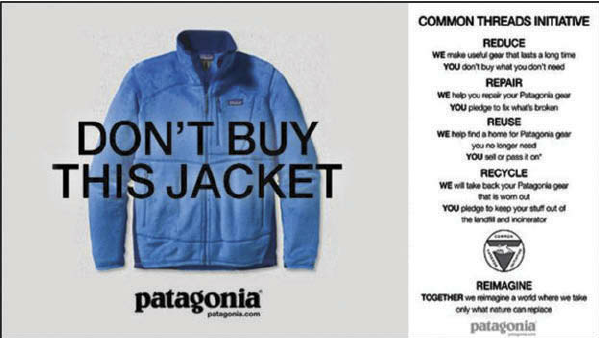#1 "Choose One" - Moms Demand Action
Back in 2013, Moms Demand Action (American) designed a marketing campaign to highlight the ‘interesting’ choices the USA had made about public/child safety. They produced a series of advertisements showing children holding items that had either been banned or had not been banned in America. In this case, a child holding a book: "Little Red Riding Hood" and another child holding what looks like an AK47.
It was of course the book that was banned, because it shows alcohol and it was thought that the book could give children the wrong impression about the implications of drinking. You might think this is a group of people wanting to see the banning of guns but this group actually supports the 2nd Amendment, but believe common-sense solutions can help decrease the escalating epidemic of gun violence that kills too many of children and loved ones every day in America.
In another image it pairs a gun with a kinder egg. The fun little chocolate treat with a toy inside. And again, it is was the kinder egg that was banned because it is a choking hazard.
Have these ads worked? Nope. It grew the Moms Demand Action following, however no noticeable progress has been made in American gun control in the past five years, and it shows no sign of changing anytime soon.
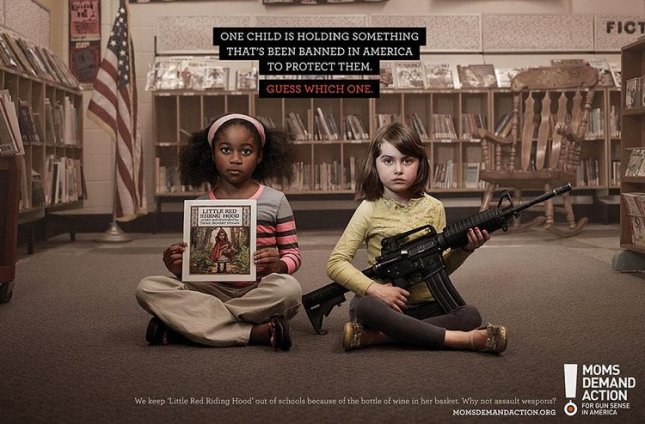
Image: Moms Demand Action
#2 "9/11" - WWF
When it comes to marketing shock tactics, there is a very fine line between what is controversial and what is disrespectful. This WWF ad below highlights the horrific killing of 9/11…and then multiplies it. The ad piggybacks on the emotional trauma that shook the world. They used tragedy to advertise tragedy.
Now, this sort of ‘tragedy advertisement’ is done all the time. Many of us live quite sheltered lives when it comes to war and conflict, so to move us into action they show us the semi-uncensored truth on what is happening all around the world. However, you have to be very careful with how you approach this.
This ad for example got it wrong. America is extremely sensitive to 9/11, (and quite rightly so!) and by making this ad it feels like WWF are poking a stick at America saying ‘9/11 wasn’t that bad, this tsunami is much worse, look at all the planes!’
So, did the ad actually work? Well, if WWF wanted to deal with a huge public backlash and release press release after press release condemning their own actions and repeatedly saying they are sorry, then yes, it worked perfectly.
Lesson to learn? Never reduce one tragedy to glorify the scale of another.

Image: WWF
#3 "Liking isn't helping" - Crisis Relief Singapore
A graphic commentary on the ‘charitable trends’ of 2013, Crisis Relief Singapore created the ‘Linking isn’t helping’ campaign to raise awareness of volunteering.
This is the kind of advert whereby the longer you look at it, the worse it gets. The child is suffering, why is no one actually helping? Why are they putting their thumbs up like they approve of this situation?
If someone told you that this ad was created yesterday, would you believe them? I’m going to guess you said yes, because even today you only have to spend a few minutes on social media and you’ll see plenty of guilt tripping posts asking for likes to ‘send thoughts and prayers’ to those suffering around the world. Something tells me this ad will be culturally relevant for many years to come…
The big question, did it work? To begin with, the ad campaign won a wide range of awards in 2014 - six in total. The ad worked and it earned our attention. But did it convert talk into action?
Considering the specific CTA (call to action) in question was to encourage volunteering, finding concrete statistics on this was s a tricky task. However, looking at the CAF – Charities Aid Foundation – World Giving Index for both 2013 and 2014, the volunteering time for both the USA and UK rose 3% and 4% respectively. Whether this advert played a role or not, we do not know.
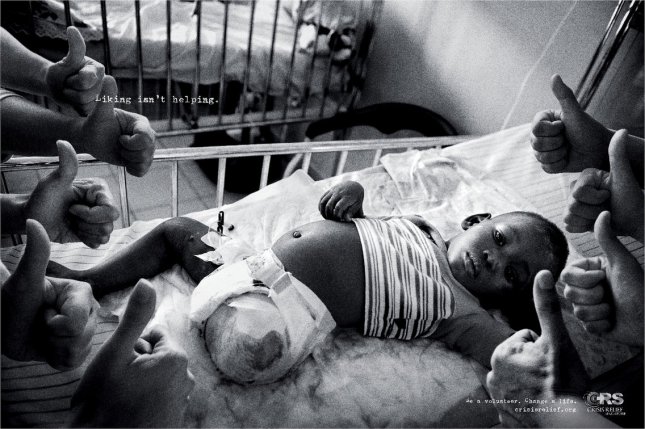
Image: Crisis Relief Singapore
#4 "The Burden" - Casa Do Menor
Hands made to look like clothes and a kid carrying his dead self around. "The Burden" doesn’t fall short on the shock factor. This Italian campaign tried to raise awareness of child abuse, and highlight in particular, the long-lasting affects abuse can have on a young person.
It makes a link between child abuse and murder, with the imagery of a child carrying the deceased version of himself around with him like a gothic rag doll. Alongside the video were print ads. For example, a child wearing a sort of dress made from grasping hands. It almost creates a sort of twisted poetic picture, highlighting that the abuse they received is part of who they are now, and they feel that pain every single day.
So, did the campaign work? Concrete evidence concerning child abuse in Italy before and after “The Burden” campaign is scarce. However, there are other indicators that point to some success. Firstly, “The Burden” did raise a few eyebrows and turn a few heads by winning the Cresta International Advertising Award Public Services 2016. Other evidence includes an article that states sexual harassment in the workplace in Italy is on the decline, “dropping from 18.7% in 2008-2009 to 12.8% in the most recent survey.” Although not directly to do with child abuse specifically, this statistic still shows the cultural mindset changes in Italy during this time.
However, it appears that more work like “The Burden” has to be done, as an article in 2017 from the BBC states that “Europe has become a ‘hub’ for child sexual abuse content”.
“The Internet Watch Foundation (IWF) found that 60% of worldwide abuse material was now in Europe – an increase of 19%”
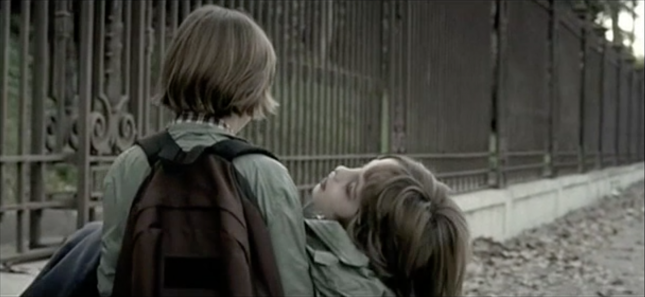
Image: Casa Do Menor
#5 "Tips from a former smoker" - CDC
A brutally honest reality check on the affects of smoking, “Tips from a former smoker” from the CDC (Centres for Disease Control and Prevention in America) back in 2012 saw a huge range of print and digital materials telling truthful, honest and personal stories from a selection of people who’ve had their lives disrupted negatively due to smoking. None of them transformed positively I might add.
From losing limbs, damaged voice boxes or having to eat through a tube, the campaign doesn’t hold back on the gritty details and shows it all. But did it work?
The CDC estimates that since the campaign launched in 2012,
“More than 5 million smokers have attempted to quit because of the campaign, and they “conservatively estimate” that more than 500,000 of those have quit for good”.
However, other measures were also underway in America to help reduce the number of smokers so it is likely that this campaign played a great communications role supporting the wider interventions already underway such as banning smoking in public spaces.
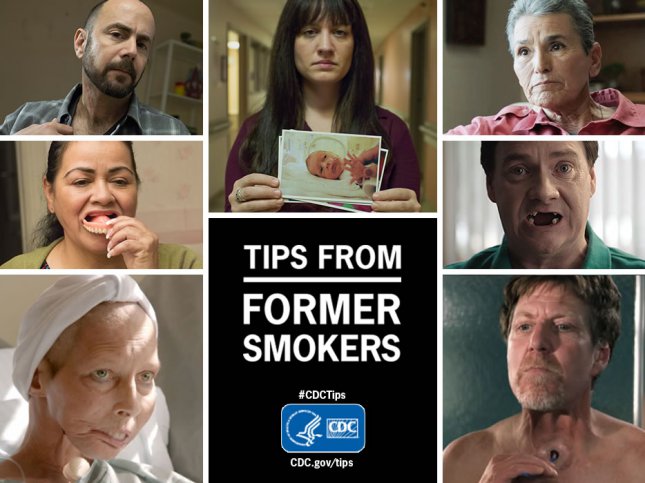
Image: CDC
#6 "Buy less" - Patagonia’s
If you were the boss of a large retail store, and the advertising and marketing team showcased their new campaign that started with “Don’t buy this jacket”, would you think they were crazy?
Patagonia, a popular outdoor clothing store ran a borderline reverse psychology campaign, that when coming from a retailer, is some shocking stuff!
Patagonia knew their audience perfectly, and so they were able to be extremely clever with how they approached this campaign. Their main target audience were outdoor enthusiasts that are environmentally conscious individuals. The campaign asked customers to not buy their jacket unless they needed to in an effort to reduce the environmental impact.
Did it work? It certainly did! The environmentally conscious target audience didn’t mind paying a bit extra for the high-quality products that Patagonia were offering, because they would be more durable, they would last longer and they wouldn’t need to replace it anytime soon. All in all,
“Patagonia’s annual sales went up almost 40 percent the following two years after the campaign first ran.” (brandpoint.com)
These sales can also represent a drop in overall jacket sales, which means Patagonia had a lovely little impact on the environment while also making a bit of profit in the process!
#7 "I wish I had breast Cancer" - Pancreatic Cancer Association
The double edged sword concerning shocking adverts, is that it divides opinion. It creates conversation but if it’s a topic that is quite sensitive, then that conversation can turn quite bitter very quickly.
Take the “I wish I had breast cancer” campaign. The tag line is extremely eye catching, because no one should ever say they wish they had cancer. However, once the audience was drawn in they soon found that pancreatic cancer sufferers face tougher odds of survival.
On one hand some have argued that any campaign that helps save even one life, is a successful campaign and should be praised rather than criticised.
However, others have expressed dislike towards the campaign for its insensitive approach and upsetting and blunt nature towards a sensitive subject. Suffers of breast cancer have also been outraged due to the tone of the message suggesting that the breast cancer is an ‘easier’ illness to have.
In an upsetting twist, Kerry Harvey, the woman presents in this particular ‘I wish I had breast cancer’ advert, sadly passed away in April 2013. Touching tributes were made in her honour and her bravery towards her tireless campaigning to help raise awareness of pancreatic cancer.
Did the campaign work?
Considering the vast amount of cancer campaigns going on around the country at any one time (quite rightly so!), it would be tricky to pinpoint exactly which campaign has impacted donations, research importance etc.
What we can say for certain is that this campaign got people talking. It helped raise the profile of pancreatic cancer, and could well have been a major contributing factor towards the largest ever UK pancreatic cancer research investment back in 2017.
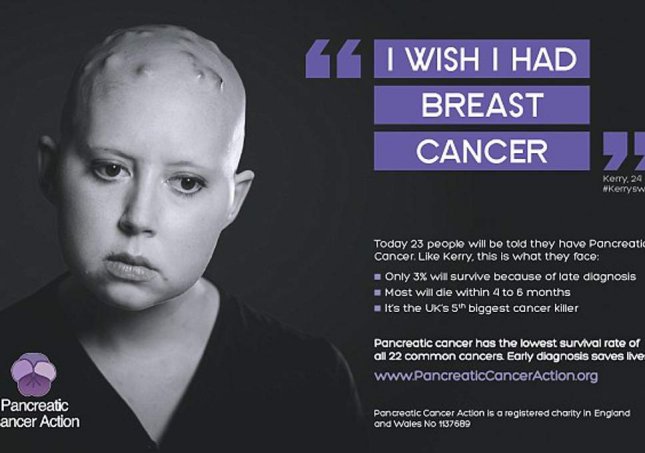
Image: Pancreatic Cancer Action
#8 "Why is it so hard to see black and blue?" - The Salvation Army
Possibly one of the most compelling use of quick thinking, linking in popular culture with a social marketing campaign, The Salvation Army really tapped into an engaged audience to share their message.
Back in 2015 “The Dress” became a talking point for – what felt like – the majority of the country. For those that don’t remember, it was a blue and black dress that, due to the lighting, meant that some people saw the dress as white and gold. A debate sprung, and people wouldn’t shut up about that stupid dress for months. (I see blue and black by the way, just saying…)
With a bit of quick thinking, The Salvation Army produced a campaign involving a white and gold version of the dress with the tag line “Why is it so hard to see black and blue”. The purpose of the ad campaign? To raise awareness of domestic abuse. What’s more is The Salvation Army tied in the campaigns release with International Women’s Day on 8th March that year.
Linking a pop culture trend with a widely recognised awareness day meant the campaign received an impressive reception.
Did it work? Well, domestic abuse rates have not seen a drastic drop over the past few years since this campaign released. However, the rate of prosecutions following domestic abuse has risen.
Although it’s not a complete victory for the campaign, it has made progress to eradicate domestic abuse!
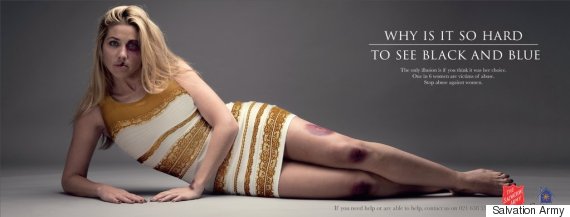
Image: The Salvation Army
#9 "Yoplait"
When a commercial business hears the term ‘social campaign’ they probably think that it isn't the right move for them. However, making a change in the world doesn’t mean you have to sacrifice profits.
When researching this topic, I came across Yoplait, and I loved their approach to brand marketing that doubled up as a powerful message towards ‘mum-shaming’.
Mum-shaming often involved the,
“Preachy or patronising information given to mothers on how to be a good parent, and the shaming of those who do not follow it.”
The advert shows a variety of scenarios about how someone might be mum-shamed, but the advert is saying ‘who cares?’ the world is still turning, build yourself a little bridge and get over it.
It links the product by saying “Now if you think that’s shocking, then check this out…” the video has already captured the audience with an honest approach to mum shaming, only to be unexpectedly advertised a brand of yogurt.
Did it work? Yes. Very much so. According to Google analytics, the ads received a 1,461% increase in brand interest. That sounds like tackling social issues and making a bit of profit to me!
Image: Yoplait
#10 "Droit des Non Fumeurs" (Smoking is being a slave to tobacco)
France has had a smoking problem history, sometimes being referred to as 'Europes Chimney'. They had to change tactics, especially since back in 2010 "40 percent of smokers between 12 and 25 are already addicted to cigarettes".
Shock tactics were employed to scare audiences into avoiding smoking by linking smoking to sexual slavery. It's fair to say this campaign stirred the media pot quite a bit! Remi Parola, head of the Non-Smokers' Rights Association that was behind the campaign stated,
"We noticed that the traditional anti-smoking campaigns no longer got across amongst the youth. We thus had to use another way in order to raise awareness"
However, not everyone had such a positive outlook on the campaigns approach. French Secretary of State for Family Nadine Morano asked for the advert to be banned following the comment, "Its purpose was to shock and not convey a message. It is a profoundly mediocre operation,"
A variety of others have critiqued the advert. Fellow teenagers and young adults echoed similar statements like "It's going to make young kids laugh. It's not going to have any effect on them. Pictures showing lungs in bad state would be more meaningful,"
Child welfare group Enfance et Partage said the campaign was cruel and insensitive toward young victims of sexual abuse and even the ever quiet tabacco makers got involved in the discussion with Yves Trevilly, spokesman for the British American Tobacco in France stating "To be compared to a pedophile because I work for a tobacco manufacturer is extremely shocking,"
After all this criticism, did the campaign work? Short answer, no. As of 2016, "about 40 percent of French 17-year-olds smoke, according to French government figures." No big change there then...
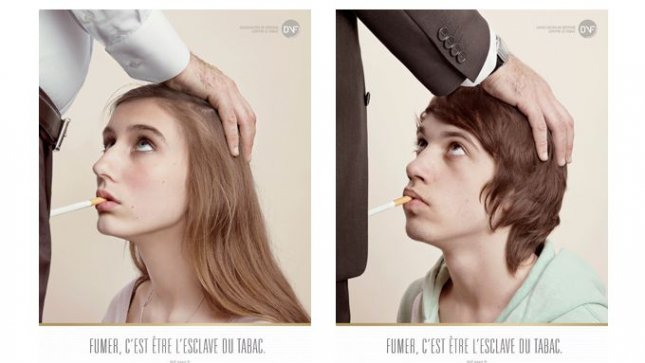
So, do shock tactics work?
I think it's fair to say that shock tactics do work. HOWEVER, you need to be extremely careful with how you approach this topic. Understanding exactly where the line is where shock advertising turns into offensive an insensitive advertising is crucial. Take the WWF 9/11 advert for example, yes sure it's shocking, but an entire country (and most of the world) would instantly see that as insensitive. It successfully reduces the deaths of countless people to something 'insignificant' i.e. the tsunami. Not a good move by WWF...
Insulting people isn't the best marketing move either. "Smoking is being a slave to tobacco" simultaneously makes the suggestion that tobacco manufacturers are pedophiles, and successfully insults and mocks those who have experienced child abuse.
However, if you look at all these 'successful' campaigns above, they all have something in common. Stop reading, scroll back up and take a look before reading on.
Do you know the connection?
Sure?
They are all grounded in current trends and realism. "Choose One" talks about guns in America in a simple and honest way (yes it didn't move American laws, but it grew the campaigns following), "Tips from a former smoker" used real shocking stories to communicate the dangers of smoking. It didn't accidentally call people pedophiles, it just told honest stories.
"I wish I had breast cancer" again, used real life subject so to communicate their message. The realism creates empathy and sympathy, espeically when you learn that the woman shown in the campaign material above, passed away a few years ago to pancreatic cancer.
"Why is it so hard to see black and blue?" is a perfect example of a marketer taking full advantage of current popular trends. By piggy backing on a widely talked about topic, and timing the campaign in with the popular international women's day, this campaign received a huge reception. Notice how it didn't shock the audience with graphic or exaggerated imagery either. Simple and honest. Sensitive and not offensive.
Then finally you have Yolplait, one of the two product marketing campaigns on this list. The marketers managed to tap into the current era of empowerment to sell their product in a way that is extremely unexpected. Maybe some of the shock factor comes from the 'so what' approach to the mum shaming stereotypes, or its the shock factor when the woman suddenly turns around and advertises a brand of yogurt after tackling an important social issue. Regardless, it's honest, it's not exaggerated and blown out of proportion.
So yes, shock tactics can work, but only if you understand fully where the line between shocking marketing and offensive marketing is. If you misjudge this line, not only will you waste time and money on a marketing campaign that isn't bringing in any customers or social attention, but you'll be battling a PR crisis in an attempt to save your reputation. If you need some help in creating your marketing campaign, get in touch and let's have a chat about how we can use our expertise to help develop your campaign in a way that, when it's done, it'll turn heads for all right reasons.
In part 2 of the this blog, I explore how us marketeers could learn a lot from our dark web counterparts.


